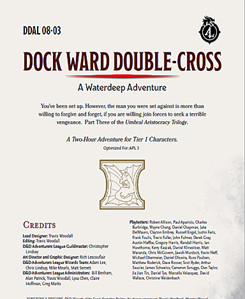 The finale of the Umbral Aristocracy trilogy, Dock Ward Double Cross, presents an engaging investigation in the Dock Ward of the City of Waterdeep, as the adventurers seek those responsible for creating the treasure maps that have been flooding the city.
The finale of the Umbral Aristocracy trilogy, Dock Ward Double Cross, presents an engaging investigation in the Dock Ward of the City of Waterdeep, as the adventurers seek those responsible for creating the treasure maps that have been flooding the city.
The encounters in the adventure are fantastic, and this adventure makes good use of the new format. I was particularly impressed by the optional complications at each location, which could be used by the DM to provide additional excitement, as well as aid in their shaping of the story. The players and DM have a lot of options as to how this adventure flows. The revelation of who is behind the maps also is excellent.
Unfortunately, all of this good work is somewhat undone by the structure of the investigation and its clues. One of the most useful clues, “it was a red-headed woman”, can only be found if the players realise that the paper of the map is unusual – something that the previous adventures haven’t mentioned. The other clues tend to the obscure. “Increased gang activity around this street” doesn’t seem relevant to “find who made the map”. There’s a jump in logic here that players and DMs may find uncomfortable. The intended solution seems to be “here are three street names; where they intersect, look for the red-headed woman”. I didn’t find this solution clear, nor have other DMs.
In theory, you can reveal the knowledge in other ways. The clues are suggestions that the DM can use to build an investigation to suit their group. I very much like this style of adventure-writing, where there’s a baseline, and then the DM has the opportunity to move beyond it. However, the baseline should work. It doesn’t help that one of the street names is almost impossible to read on the provided map, which makes the solution harder than it should be. (That street is also called both “Old” and “Odd” street in the text – a minor typographical error that causes more problems!)
The links to the bonus objectives are not that obvious; I think the DM needs to do more work for them to come into play, although it is possible a group might stumble across them. Unlike some other adventures, the bonus objectives provide significant content. They also display some of the problems with the design of bonus objectives; if both were used and had obvious entry points, then the investigation would be enriched. Not using the objectives significantly weakens the investigation.
The final combat can be very difficult; more than a few groups have lost characters to the boss. If you have a mixed group of characters that seem “average” but includes level 1 characters, beware! I’m quite happy to see a villain using a pistol, but some players may not be! It does deal a lot of damage when it hits or, worse, critically hits!
Characters that kill everything that moves are likely to have trouble discovering the purpose of the maps, but while the main villain doesn’t talk, their underlings are more than happy to confess everything.
If I consider the trilogy as a whole, I think there’s a lot of very good design on display. The underlying plot is excellent and leads to a brilliant twist at the end of part 2. The story fits nicely with the plot of Dragon Heist and can enrich your players’ enjoyment of that adventure. Where it stumbles is often due to a lack of attention to detail, and a structure that needed more work to make the parts start and finish well.
Dock Ward Double Cross could easily work as a stand-alone adventure, but also shines as the conclusion of the trilogy. Each DM needs to determine if the investigation structure works for their group and adjust it if it doesn’t. However, the individual encounters and characters work very well. It’s flawed, but there’s much to like.
